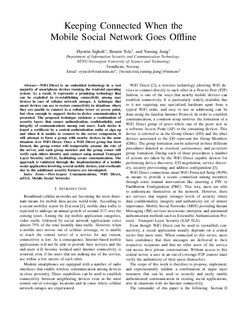| dc.contributor.author | Sigholt, Øystein Løkken | |
| dc.contributor.author | Tola, Besmir | |
| dc.contributor.author | Jiang, Yuming | |
| dc.date.accessioned | 2020-03-17T13:15:38Z | |
| dc.date.available | 2020-03-17T13:15:38Z | |
| dc.date.created | 2020-02-06T13:56:47Z | |
| dc.date.issued | 2019 | |
| dc.identifier.citation | IEEE International Conference on Wireless and Mobile Computing, Networking, and Communications. 2019, 59-64. | nb_NO |
| dc.identifier.issn | 2160-4886 | |
| dc.identifier.uri | http://hdl.handle.net/11250/2647204 | |
| dc.description.abstract | WiFi Direct is an embedded technology in a vast majority of smartphone devices running the Android operating system. As a result, it represents a promising technology that can be exploited in re-establishing connectivity among user devices in case of cellular network outages. A technique that smart devices can use to restore connectivity in situations where they are unable to connect to a cellular tower or access point, but close enough to support device-to-device communication is presented. The proposed technique envisions a combination of security layers that ensure authentication, confidentiality, and integrity of communications among end users. Each device is issued a certificate by a central authentication entity at sign up and when it is unable to connect to the server component, it will attempt to form a group with nearby devices in the same situation over WiFi Direct. Once a WiFi Direct group has been formed, the group owner will temporarily assume the role of the server, and each group member and the group owner will verify each others identity and connect using mutual Transport Layer Security (mTLS), facilitating secure communication. The approach is validated through the implementation of a mobile social application involving several mobile devices, and overheads due to the additional security features are investigated. | nb_NO |
| dc.language.iso | eng | nb_NO |
| dc.publisher | IEEE | nb_NO |
| dc.title | Keeping Connected When the Mobile Social Network Goes Offline | nb_NO |
| dc.type | Journal article | nb_NO |
| dc.type | Peer reviewed | nb_NO |
| dc.description.version | acceptedVersion | nb_NO |
| dc.source.pagenumber | 59-64 | nb_NO |
| dc.source.journal | IEEE International Conference on Wireless and Mobile Computing, Networking, and Communications | nb_NO |
| dc.identifier.doi | 10.1109/WiMOB.2019.8923549 | |
| dc.identifier.cristin | 1791628 | |
| dc.description.localcode | © 2019 IEEE. Personal use of this material is permitted. Permission from IEEE must be obtained for all other uses, in any current or future media, including reprinting/republishing this material for advertising or promotional purposes, creating new collective works, for resale or redistribution to servers or lists, or reuse of any copyrighted component of this work in other works. | nb_NO |
| cristin.unitcode | 194,63,30,0 | |
| cristin.unitname | Institutt for informasjonssikkerhet og kommunikasjonsteknologi | |
| cristin.ispublished | true | |
| cristin.fulltext | postprint | |
| cristin.qualitycode | 1 | |
